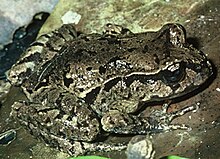Maud Island frog
| Maud Island frog | |
|---|---|
 |
|
| Leiopelma pakeka | |
| Scientific classification | |
| Kingdom: | Animalia |
| Phylum: | Chordata |
| Subphylum: | Vertebrata |
| Class: | Amphibia |
| Superorder: | Batrachia |
| Order: | Anura |
| Family: | Leiopelmatidae |
| Genus: | Leiopelma |
| Species: | L. pakeka |
| Binomial name | |
|
Leiopelma pakeka Bell, Daugherty & Hay, 1998 |
|
 |
|
| Range of Maud Island Frog | |
|
|
The Maud Island frog, Leiopelma pakeka, is a primitive frog native to New Zealand, one of only four extant species belonging to the family Leiopelmatidae.
L. pakeka is a small terrestrial frog, growing to 5 cm in length, and is medium to dark brown with unwebbed toes and a distinctive extended ridge behind its eye. It is slightly larger than and differs slightly in colour from Hamilton's frog (Leiopelma hamiltoni).
Like other members of the genus Leiopelma, Maud Island frogs lay their eggs on moist ground. One to 19 eggs are laid in December, and are guarded by the male for 14–21 weeks. The eggs hatch into froglets which the male carries on its back until they become independent.
Long-term studies beginning in 1983 have revealed this species is extremely long-lived: some monitored frogs reach 35–40 years old, making them the longest-lived wild frog in the world. Individuals are well-camouflaged and sedentary, spending their whole lives within a 30 square metre area and moving the centre of their home range only 1.3 m every ten years – one of the smallest home ranges known for any vertebrate.
The frogs on Maud Island in Pelorus Sound, Marlborough, were discovered in 1940 and formally reported in 1958; they resembled L. hamiltoni found on nearby Stephens Island and were considered to be a subpopulation of that species. In 1998 an analysis of the muscle proteins (allozymes) of L. hamiltoni from both islands showed enough differences that the Maud Island population was designated a separate species, name L. pakeka from the Māori word for Maud Island. This then meant that the total world population of L. hamiltoni was less than 300 individuals living in a small pile of rocks on Stephens Island.
Recent studies of from all four extant Leiopelma species do not support the results of the allozyme analysis, however: the genetic difference between L. pakeka and L. hamiltoni is no greater than that seen between different populations of Archey's frog (L. archeyi), which calls into question the designation of the Maud Island frog as a separate species. A similar conflict between blood allozymes and DNA led to the lumping of the Brothers Island tuatara (Sphenodon guntheri) back into Sphenodon punctatus.
...
Wikipedia

